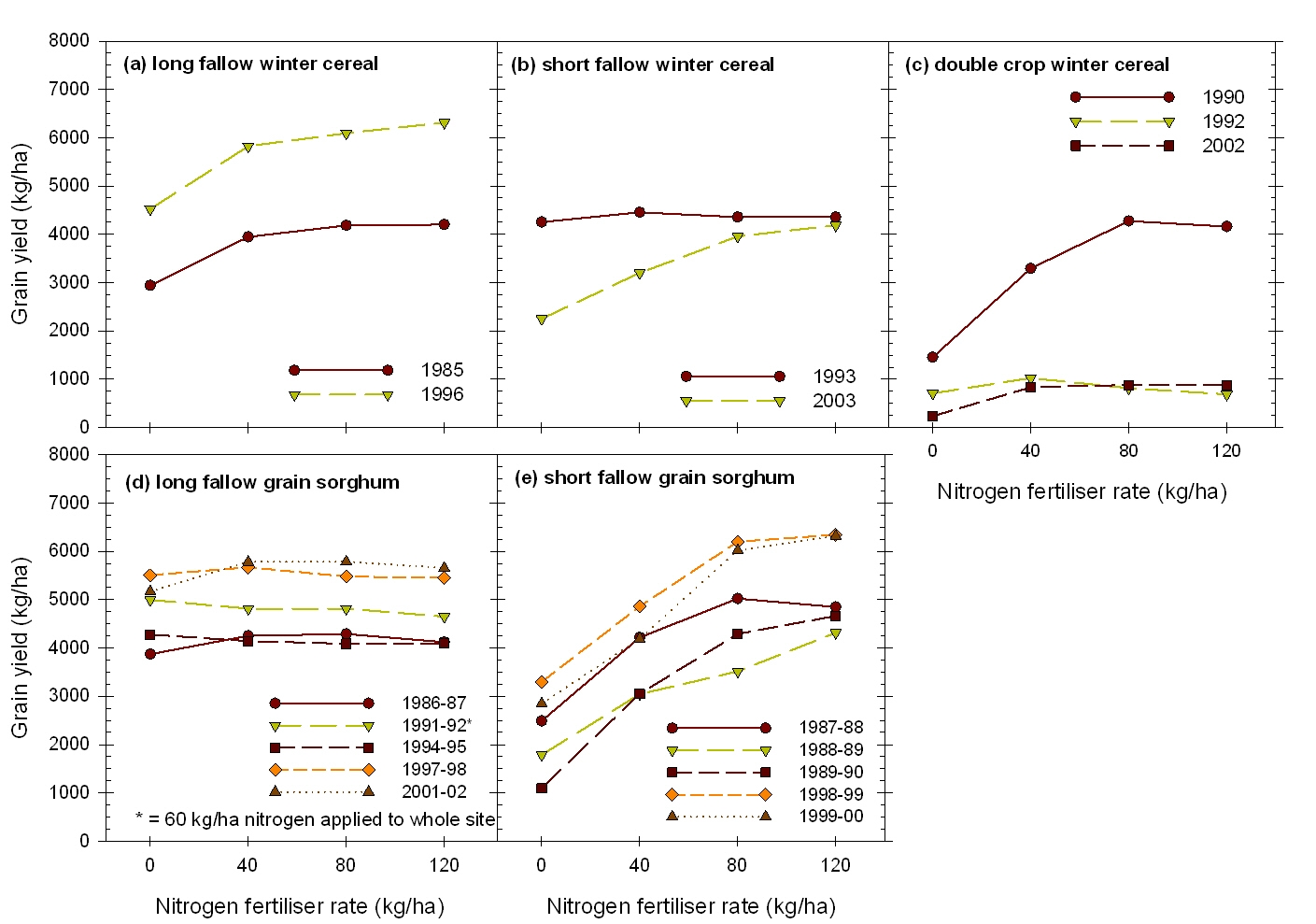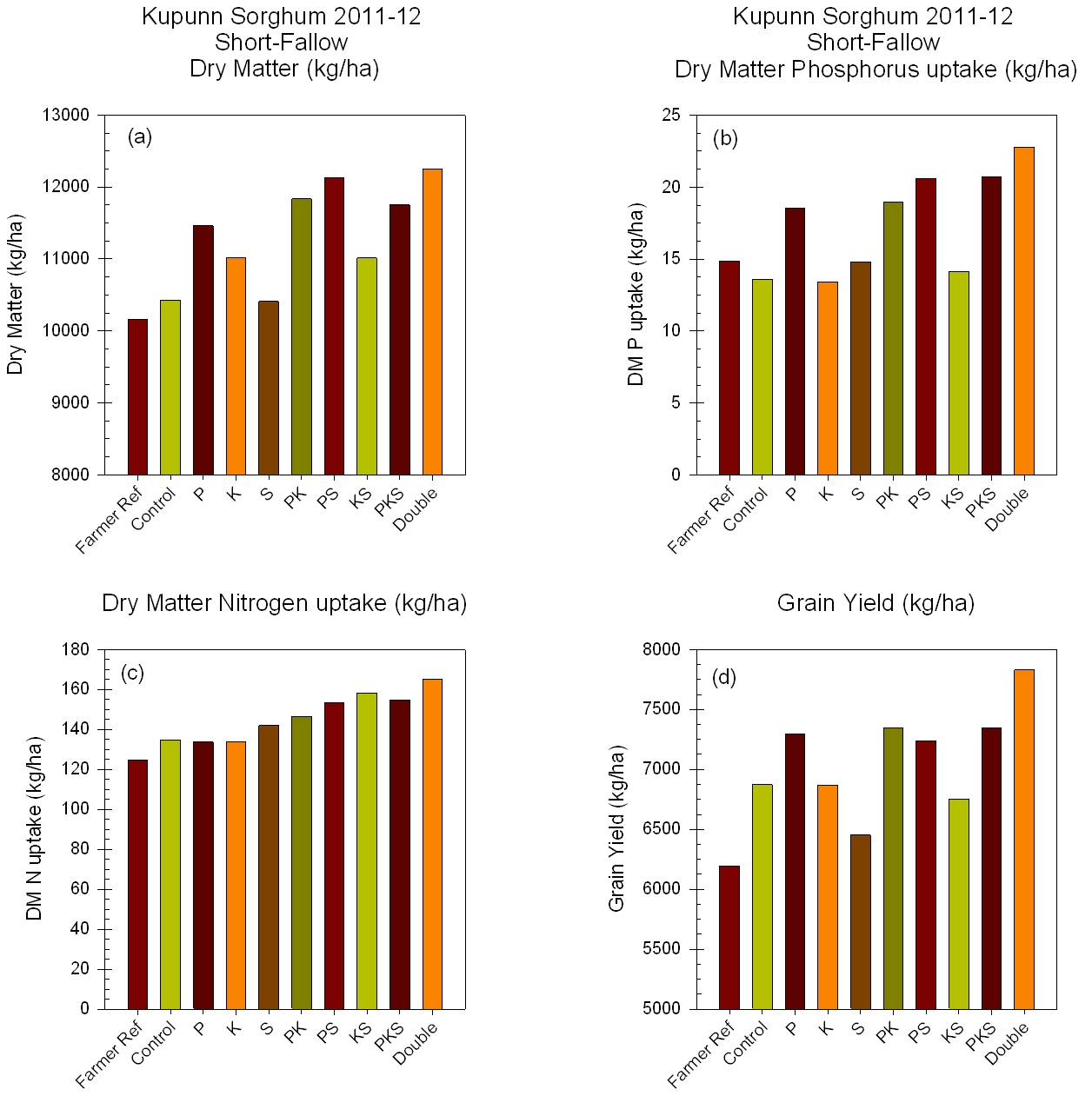Nutritional interactions of N, P, K and S on the Darling Downs
Author: David Lester, Department of Agriculture, Fisheries and Forestry (DAFF), and Mike Bell, Queensland Alliance for Agriculture and Food Innovation (QAAFI) | Date: 07 Mar 2013
David Lester, Department of Agriculture, Fisheries and Forestry (DAFF), and
Mike Bell, Queensland Alliance for Agriculture and Food Innovation (QAAFI)
Take home message
Order of priority: Nitrogen first, phosphorus second, potassium and sulfur third;
Additive affects of nitrogen and phosphorus together appear to account for most of above ground growth and yield response;
Gathering more evidence that plants seem to be better able to feed themselves where phosphorus is applied at low soil test values.
Shallow applications of nitrogen and phosphorus
The current practice of relatively shallow applications of nitrogen and phosphorus are confirming yield responses to these nutrients in the long-term on the Darling Downs. Looking at the long-term grain yield data from the Incitec-Pivot “Colonsay” trial (Fig. 1) nitrogen application at 80 kg/ha per crop increased grain yield by 40% (19 t/ha) over nil nitrogen application without phosphorus input. However when phosphorus was added, cumulative yield was increased by a further 10% (7 t/ha) compared to nil P.
These yields are treatments of plots receiving the same applications, rainfall and management for each crop.

Figure 1: Cumulative grain yield of seventeen crops from 1985 to 2003 versus cumulative nitrogen application at four phosphorus rates at Colonsay, Darling Downs, Qld.
So that tells us that nitrogen and phosphorus can increase grain yields in the long-term. But what about which crops are more responsive? Are there combinations of preceding fallow and crop that are more or less responsive to nitrogen or phosphorus?
In general, grain yield of short-fallow winter or summer cereal crops consistently increased with fertiliser nitrogen application (Fig. 2). Long-fallow crops, where a greater period of nitrogen mineralisation has occurred reduces the responsiveness to fertiliser nitrogen application. Phosphorus application did not show a consistent response across combinations of preceding fallow period and crop, hence decisions on phosphorus should remain focussed on each crop and consider other parameters such as but not limited to, soil test values and species sensitivity to Arbuscular Mycorrhizal Fungi.

Figure 2: Grain yield (kg/ha) for five fallow period / crop combinations at four fertiliser nitrogen rates at Colonsay, Darling Downs, Qld from 1985 to 2003.
What about deep placed phosphorus, sulfur and potassium?
Several experiments across northern NSW, southern and central Qld have focussed on asking the question “are crops responding to P, K and S applications on their own, or in interaction with each other?”
Results of these experiments suggest that phosphorus is a key element for increasing crop growth and performance. They also suggest it is a pre-requisite for crop responses to potassium or sulfur, i.e. you are unlikely to get a response to K or S without adequate P being present.
Some data from a site at Kupunn demonstrate (Fig. 3) this effect. The measurements taken now include some “farmer practice” references to benchmark against, or how much crop can be grown just doing as you are now. Soil is effectively left as it is, with no tillage or fertiliser applied other than what is done as part of the normal operations.
All treatments, including control would receive deep tillage (roughly to 20 cm) in the year of application and an equivalent nitrogen rate so all plots get the same amount of N regardless of how much P, K or S is also applied.
Dry matter and phosphorus uptake was increased mainly with treatments receiving phosphorus (Fig. 3a and b), those treatments getting P are greater than those not getting it. The increases in dry matter carried through to increased nitrogen uptake by the crop (Fig. 3c) and grain yield (Fig. 3d). Grain yields of control are 11% greater than the farmer reference; and with P applied are 6% greater than the than control. The double PKS treatment grain yield was 500 kg/ha over the P only treatment, suggesting some rate response may be present.
Overall, the P only treatment was 1100 kg/ha (18%) greater than the farmer reference.

Figure 3: Dry matter, phosphorus uptake, nitrogen uptake and grain yield in a short fallow sorghum crop at Kupunn in 2011-12.
Sites in central Qld and northern NSW also demonstrate greater uptake of nitrogen, potassium and sulfur when phosphorus application is made (data not shown).
Conclusions
The combination of these long and short-term nutrition experiments indicate a hierarchy of fertility needs. There must be sufficient plant available nitrogen to get a phosphorus response, and there must be sufficient phosphorus for sulfur and / or potassium responses to occur.
Further research in to the response to different application rates and product combinations is currently underway.
Contact details
David Lester
Department of Agriculture, Fisheries and Forestry
Phone 07 4639 8886
Fax 07 4639 8800
Email david.lester@daff.qld.gov.au
Was this page helpful?
YOUR FEEDBACK
